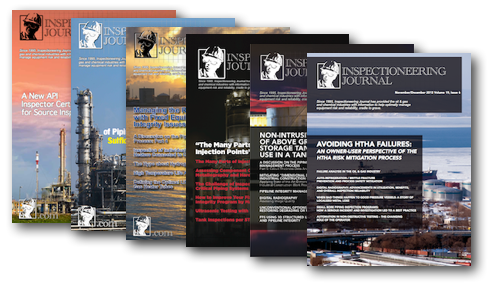In 2013 Inspectioneering published content covering a wide array of topics, from risk-based inspection, to advanced nondestructive testing methods, to pipeline integrity management systems. Last year, we published more content than any year prior; we expect the same trend to continue into 2014. Take a look at ten of the most popular articles that were published in Inspectioneering Journal last year below.

Unconventional Options for Restoring Degrading or Failing Assets
By Matt Green, Neptune Research, Inc. This article originally appeared in the September/October 2013 issue of Inspectioneering Journal.
From the article:
As composite repair technology continues to gain acceptance and is being more widely utilized, owner/operators are finding that they are useful in a variety of situations. The days of thinking of composite repair materials as a last resort or even as a new or risky option are slowly, but surely, fading. When the ASME PCC-2 and ISO/TS-24817 were first published in 2006, the idea of composite repairs being used for high risk or Class 3 piping repairs was still a novelty. Over seven (7) years later, repairs are being implemented using this technology on a daily basis as part of the routine maintenance programs in facilities and on pipelines around the world.
A New API Inspector Certification Program Program for Source Inspectors
By John Reynolds, Intertek. This article originally appeared in the January/February 2013 issue of Inspectioneering Journal.
From the article:
A new API Individual Certification Program (ICP) will be offered soon to certify inspectors who perform quality assurance (QA) surveillance and inspection activities on new materials and equipment for the energy and chemical (E&C) industry. It is being developed by the API with the assistance of numerous, experienced subject matter experts (SMEs) involved in source inspection activities. Passing an examination to demonstrate the individual’s knowledge of important quality assurance activities will be one of the basic requirements of this ICP. The program will be applicable to all segments of the E&C industry including upstream (e.g. exploration and production), mid-stream (e.g. pipelines and distribution), and downstream (refining and chemical manufacturing). The initial offering will be focused on entry level source inspectors of mechanical fixed equipment; while future offerings are planned to be focused on intermediate and advanced level source inspectors of mechanical – fixed equipment, mechanical – rotating equipment, instrumentation and electrical equipment and materials.
Read Related Articles
- A New API Inspector Certification Program for Source Inspectors
- The Role of Record-keeping and Data Management in Achieving Excellence in Pressure Equipment Integrity and Reliability
- The Role of Continuous Improvement in Achieving Excellence in Pressure Equipment Integrity and Reliability
- The Role of Risk Assessment and Inspection Planning in Achieving Excellence in Pressure Equipment Integrity and Reliability
A Discussion on the Piping Thickness Management Process - Parts 3 through 5
By A.C. Gysbers, The Equity Engineering Group. These articles appeared in the following Inspectioneering Journal issues: January/February 2013, May/June 2013, and September/October 2013.
From part 3 of the series:
Piping failures still represent a frustrating and ongoing problem for processing plants. Failures are still commonly reported and contribute to large losses. In the author’s experience, piping represents the highest percentage of fixed equipment failures in petroleum refining. Of course, there are many factors within a pressure equipment integrity program (PEIP) that can contribute to piping integrity problems including design issues, operating window compliance, management of change issues, etc.
Read the articles: Part 3, part 4, or part 5.
Executive Q&A with Ryan Sitton, President and CEO, PinnacleAIS
This article appeared in the September/October 2013 issue of Inspectioneering Journal.
From the article:
As most people in this industry know, the OSHA PSM standard came out in the early 90s and that really began to raise the bar, not just for mechanical integrity programs, but for PSM programs across the board. Since then, we’ve had a number of industry incidents and technological advances that have improved what we can do with all of these programs, and in particular, MI programs. In addition, there have been numerous industry initiatives that have been started by regulators, and more and more companies have had an opportunity to see the value of an effective MI program. That has driven the need or opportunity to improve programs across the board, so a lot of people are performing assessments to get an idea where they can go moving forward.
The Hype About Hydrogen Bake-outs
By Marc McConnell, PinnacleAIS. This article appeared in the May/June 2013 issue of Inspectioneering Journal.
From the article:
A bake-out is used to drive hydrogen out of the steel, as trapped hydrogen can cause cracking in the weld. Actually, trapped hydrogen can cause cracking in the entire vessel, but let’s focus on weld repairs first. This type of cracking has many names, and is often called delayed cracking, cold cracking, hydrogen assisted cracking, hydrogen induced cracking, and hydrogen embrittlement.
XRF Inspection of Piping Systems to Reduce Sulfidation Corrosion Risk
By John Morgan and William Fotoples, Thermo Fisher Scientific. This article appeared in the March/April 2013 issue of Inspectioneering Journal.
From the article:
Sulfidic corrosion of piping and equipment within the refining industry continues to be a significant cause of leaks and issues that can lead to early replacements, unplanned outages, and incidents potentially resulting in loss of property and injury to workers. Carbon steels with low silicon (<0.10%) content have been shown to corrode at an accelerated rate when exposed to sulfidation corrosion conditions.
How to Improve Your Fixed Equipment Mechanical Integrity Program by Managing Your Manager(s)
By John Reynolds, Intertek. This article appeared in the July/August 2013 issue of Inspectioneering Journal.
From the article:
I know it may sound a bit strange to think in terms of managing your manager(s), but it is very important, especially when some types of managers do not really understand or appreciate the criticality of the FEMI role in meeting business needs. Some managers view the FEMI role at the operating site as a “necessary evil”, or at best, something they have to do in order to stay in compliance with rules and regulations. These types of managers need a lot of upward management and enlightenment from those of us who are dedicating our careers to seeking excellence in FEMI. I also know that it is easier for us FEMI specialists to manage FEMI programs and activities than it is to manage our manager(s); but if we do not manage our manager(s) too, we could end up constantly “pushing on the rope”, as they say, without much success at improving our FEMI programs.
Assessing Component Condition Using Remote Metallography and Hardness Testing
By Oscar Quintero at M&M Engineering Associates. This article appeared in the July/August 2013 issue of Inspectioneering Journal.
From the article:
Remote metallography, in-place metallography, in-situ metallography, and field replication are all examples of typical trade names of this great tool used for assessing the condition of a metal component. Often this method is used to determine if a metal component was exposed to high temperatures, allowing the observation of the microstructure of such component without the sample being removed.
If you'd like to stay up-to-date with the latest Inspectioneering Journal articles and obtain access to over 20 years of archived Inspectioneering Journal content, take a moment to learn more about our subscription options by clicking here.
















Comments and Discussion
There are no comments yet.
Add a Comment
Please log in or register to participate in comments and discussions.